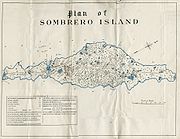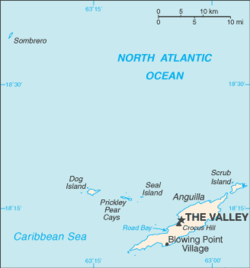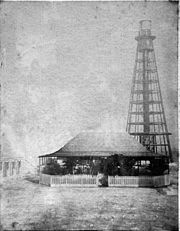
Sombrero, Anguilla
Encyclopedia


Lesser Antilles
The Lesser Antilles are a long, partly volcanic island arc in the Western Hemisphere. Most of its islands form the eastern boundary of the Caribbean Sea with the Atlantic Ocean, with the remainder located in the southern Caribbean just north of South America...
in position 18° 60'N, 63° 40'W. It lies 34 miles (54.7 km) north west of Anguilla
Anguilla
Anguilla is a British overseas territory and overseas territory of the European Union in the Caribbean. It is one of the most northerly of the Leeward Islands in the Lesser Antilles, lying east of Puerto Rico and the Virgin Islands and directly north of Saint Martin...
across the Dog and Prickly Pear Passage. The distance to Dog Island
Dog Island, Anguilla
Dog Island is an uninhabited small island of 511 acres in size located approximately 13km to the northwest of Anguilla.-References:...
, the closest island of Anguilla, is 24 miles (38.6 km). Sombrero is 0.9 miles (1.4 km) long north-south, and 0.25 mile (0.402335 km) wide. The land area is 95 acres (384,451.7 m²). Originally, when viewed from the sea, the island had the shape of a sombrero hat
Sombrero
Sombrero in English refers to a type of wide-brimmed hat originating in Mexico. In Spanish, however, it is the generic word for "hat", which originates from "sombra", meaning "shade"....
but mining operations have left the island with precipitous sides and a relatively flat top which is 40 feet (12.2 m) above sea level. The surface of the island is rough, and vegetation is sparse.
This mining operation yielded some 3000 ton
Ton
The ton is a unit of measure. It has a long history and has acquired a number of meanings and uses over the years. It is used principally as a unit of weight, and as a unit of volume. It can also be used as a measure of energy, for truck classification, or as a colloquial term.It is derived from...
s of phosphate a year by 1870. By 1890, the phosphate reserves had been exhausted.
Lighthouse
The lighthouse marks the Anegada PassageAnegada Passage
Anegada Passage is a strait in the Caribbean, at . It separates the British Virgin Islands and Sombrero Island of Anguilla....
, which is the route from Europe into the Caribbean. The first lighthouse was erected in 1868. In 1960, Hurricane Donna
Hurricane Donna
Hurricane Donna in the 1960 Atlantic hurricane season was a Cape Verde-type hurricane which moved across the Leeward Islands, Puerto Rico, Hispanola, Cuba, The Bahamas, and every state on the East Coast of the United States...
damaged this lighthouse, with the result that a new lighthouse replaced it in 1962. The lighthouses were manned from 1868 to 2001. In that year, Trinity House
Trinity House
The Corporation of Trinity House of Deptford Strond is the official General Lighthouse Authority for England, Wales and other British territorial waters...
donated and installed the current, automated tower, which is a 50' round tower, painted white. The Government of Anguilla's Department of Fisheries and Marine Resources is responsible for the maintenance of the navigational aids.
History
As a result of the Treaty of UtrechtTreaty of Utrecht
The Treaty of Utrecht, which established the Peace of Utrecht, comprises a series of individual peace treaties, rather than a single document, signed by the belligerents in the War of Spanish Succession, in the Dutch city of Utrecht in March and April 1713...
in 1714, Sombrero passed into the hands of the British
United Kingdom of Great Britain and Ireland
The United Kingdom of Great Britain and Ireland was the formal name of the United Kingdom during the period when what is now the Republic of Ireland formed a part of it....
. Captain Warwick Lake
Viscount Lake
Viscount Lake, of Delhi and Laswary and of Aston Clinton in the County of Buckingham, was a title in the Peerage of the United Kingdom. It was created in 1807 for the prominent soldier Gerard Lake, 1st Baron Lake. He was Commander-in-Chief of India from 1801 to 1805 and from 1805 to 1807...
of Recruit
HMS Recruit (1806)
HMS Recruit was an 18-gun Cruizer class brig-sloop of the Royal Navy, launched in 1806 at Sandwich, Kent. She is best known for an act of pique by Cmdr. Warwick Lake, who marooned a seaman, and for an inconclusive but hard fought ship action under Cmdr. Charles John Napier against the French...
marooned an impressed seaman, Robert Jeffrey, there on 13 December 1807. As it turned out, Jeffrey survived, a passing American vessel having rescued him. Still, a court-martial dismissed Lake from the Royal Navy.
In 1814, and again in 1825, a British geologist
Geology
Geology is the science comprising the study of solid Earth, the rocks of which it is composed, and the processes by which it evolves. Geology gives insight into the history of the Earth, as it provides the primary evidence for plate tectonics, the evolutionary history of life, and past climates...
surveyed the island and found that it abounded in phosphate of lime (guano)
Guano
Guano is the excrement of seabirds, cave dwelling bats, and seals. Guano manure is an effective fertilizer due to its high levels of phosphorus and nitrogen and also its lack of odor. It was an important source of nitrates for gunpowder...
and reported this to the British government.
In 1856 the Americans claimed the island, and in a very short period of time quarried 100,000 tons of phosphate that served as fertilizer for the exhausted lands of the Southern States
Southern United States
The Southern United States—commonly referred to as the American South, Dixie, or simply the South—constitutes a large distinctive area in the southeastern and south-central United States...
. Uniquely, an important insurrection occurred when West Indian black workers revolted against the “slavery proclivities” of a white American superintendent vis-à-vis wage-earning free men. Four of the 200 workers "fatally injured" Superintendent Snow and commandeered the island and company money and stores.
The British later intervened and demanded compensation from the United States for the occupation. The conflicting claims to the island were settled in Britain's favour in 1867.
Sombrero, lying in the route of shipping from England to South and Central America
Central America
Central America is the central geographic region of the Americas. It is the southernmost, isthmian portion of the North American continent, which connects with South America on the southeast. When considered part of the unified continental model, it is considered a subcontinent...
, lay in an area with many hazards and in 1848 the Admiralty
Admiralty
The Admiralty was formerly the authority in the Kingdom of England, and later in the United Kingdom, responsible for the command of the Royal Navy...
was asked to install a light on it. On 30 June 1859, the Royal Mail Steam Packet Company
Royal Mail Steam Packet Company
The Royal Mail Steam Packet Company was a British shipping company founded in London in 1839 by Scot James Macqueen. After good and bad times it became the largest shipping group in the world in 1927 when it took over the White Star Line....
's ship Paramatta was wrecked on her maiden voyage on Horseshoe Reef, which resulted in another request to the Admiralty. The lighthouse
Lighthouse
A lighthouse is a tower, building, or other type of structure designed to emit light from a system of lamps and lenses or, in older times, from a fire, and used as an aid to navigation for maritime pilots at sea or on inland waterways....
was then built and first exhibited its light on the evening of 1 January 1868. In 1871, the lease of the island was sold for £55,000 and then sold again for £110,000 to the New Sombrero Phosphate Company, which led to litigation in Erlanger v. New Sombrero Phosphate Co (1878) 3 App Cas 1218.

Cornwall
Cornwall is a unitary authority and ceremonial county of England, within the United Kingdom. It is bordered to the north and west by the Celtic Sea, to the south by the English Channel, and to the east by the county of Devon, over the River Tamar. Cornwall has a population of , and covers an area of...
mining engineer, Thomas Corfield, was Superintendent
Management
Management in all business and organizational activities is the act of getting people together to accomplish desired goals and objectives using available resources efficiently and effectively...
of Sombrero. His duties included organizing the conveying of the guano to a spot which was convenient for loading the lighters
Lighter (barge)
A lighter is a type of flat-bottomed barge used to transfer goods and passengers to and from moored ships. Lighters were traditionally unpowered and were moved and steered using long oars called "sweeps," with their motive power provided by water currents...
to take the guano to the ships lying off the island, overseeing the construction of derrick
Derrick
A derrick is a lifting device composed of one tower, or guyed mast such as a pole which is hinged freely at the bottom. It is controlled by lines powered by some means such as man-hauling or motors, so that the pole can move in all four directions. A line runs up it and over its top with a hook on...
s and engine houses, and arranging for the laying of the tram
Tram
A tram is a passenger rail vehicle which runs on tracks along public urban streets and also sometimes on separate rights of way. It may also run between cities and/or towns , and/or partially grade separated even in the cities...
lines for the wagons, which were loaded at the quarries. The guano was just piled in dumps near the engine houses and derricks. There was no semblance of a port
Port
A port is a location on a coast or shore containing one or more harbors where ships can dock and transfer people or cargo to or from land....
and no beach.
The black workers were recruited from various islands and lived in wooden huts during their term of service. Stores and various supplies were obtained from a merchant at Philipsburg
Philipsburg, Netherlands Antilles
Philipsburg is the main town and capital of the country of Sint Maarten, on a narrow stretch of land between Great Bay and the Great Salt Pond. It functions as the commercial center of Saint Martin island, whereof Sint Maarten encompasses the southern half...
, Sint Maarten, a Mr Nesbit. The company's schooner
Schooner
A schooner is a type of sailing vessel characterized by the use of fore-and-aft sails on two or more masts with the forward mast being no taller than the rear masts....
, the Logos, brought supplies and also took the black labourers to and from their homes on the other islands.
The superintendent's house was a wooden bungalow
Bungalow
A bungalow is a type of house, with varying meanings across the world. Common features to many of these definitions include being detached, low-rise , and the use of verandahs...
near the middle of the island and round it were grouped the quarters of the technicians, store keepers, and lighthouse keepers, and other wooden buildings. On the side opposite to the main buildings was a small building for the superintendent. There was a wide veranda round the house and he used to live there with his family, except near the hurricane season
Hurricane season
Hurricane season refers to a period in a year when hurricanes usually form. For more information see: Tropical cyclone#Times.* The Atlantic hurricane seasonFor a lists of past seasons, see:...
.
In 1890, the phosphate works on the island were abandoned and by 1893 the lighthouse had come under the authority of the British Board of Trade
Board of Trade
The Board of Trade is a committee of the Privy Council of the United Kingdom, originating as a committee of inquiry in the 17th century and evolving gradually into a government department with a diverse range of functions...
, later the Department of Transport
Department for Transport
In the United Kingdom, the Department for Transport is the government department responsible for the English transport network and a limited number of transport matters in Scotland, Wales and Northern Ireland which are not devolved...
. Administration of the light was carried out by Trinity House
Trinity House
The Corporation of Trinity House of Deptford Strond is the official General Lighthouse Authority for England, Wales and other British territorial waters...
. In 1931, the old light system was changed and improved to 200,000 candle power and the tower received its first major repair as the basement was encased in concrete. On 20 July 1962, after the destruction caused by Hurricane Donna
Hurricane Donna
Hurricane Donna in the 1960 Atlantic hurricane season was a Cape Verde-type hurricane which moved across the Leeward Islands, Puerto Rico, Hispanola, Cuba, The Bahamas, and every state on the East Coast of the United States...
in 1960, the present lighthouse was put into operation and the old tower demolished on 28 July 1962. The lighthouse is located near the centre of the island, and reaches a height of almost 166 feet (50.6 m) above sea level. It protects ships passing from the Atlantic Ocean to the Caribbean Sea through the Anegada Passage
Anegada Passage
Anegada Passage is a strait in the Caribbean, at . It separates the British Virgin Islands and Sombrero Island of Anguilla....
. Full responsibility for the light passed from Trinity House to the Anguillan government on 1 December 2001.
Population
Until recently the only inhabitants were the staff of the lighthouseLighthouse
A lighthouse is a tower, building, or other type of structure designed to emit light from a system of lamps and lenses or, in older times, from a fire, and used as an aid to navigation for maritime pilots at sea or on inland waterways....
but the light was automated in 2002 and now the island is uninhabited. The only visitors are the occasional fishermen, biologists engaged in fieldwork, and the occasional SCUBA group visiting the island for its interesting dive sites and post-apocalyptic surface.
Wildlife
The island is noted for the endemic Black lizard (Sombrero AmeivaSombrero Ameiva
The Sombrero Ameiva is a lizard species in the genus Ameiva. It is endemic to Sombrero, a small, uninhabited island in the Lesser Antilles under the jurisdiction of Anguilla...
), a widespread and easily seen lizard species on the island. A recently discovered dwarf gecko Spaerodactylus sp. may be endemic and has been tentatively named Sombrero dwarf gecko. The lizard Anolis gingivinus also inhabits the island.
The surrounding waters are feeding areas for hawksbill turtle
Hawksbill turtle
The hawksbill sea turtle is a critically endangered sea turtle belonging to the family Cheloniidae. It is the only extant species in its genus. The species has a worldwide distribution, with Atlantic and Pacific subspecies. E. imbricata imbricata is the Atlantic subspecies, while E...
s. During the late Pleistocene
Pleistocene
The Pleistocene is the epoch from 2,588,000 to 11,700 years BP that spans the world's recent period of repeated glaciations. The name pleistocene is derived from the Greek and ....
, the island was inhabited by a now-extinct giant tortoise, Chelonoidis sombrerensis.
Sombrero also supports internationally important numbers of the following seabirds.
- Masked BoobyMasked BoobyThe Masked Booby, Sula dactylatra, is a large seabird of the booby family, Sulidae. This species breeds on islands in tropical oceans, except in the eastern Atlantic; in the eastern Pacific it is replaced by the Nazca Booby, Sula granti, which was formerly regarded as a subspecies of Masked Booby...
s Sula dactylatra: 27 pairs (54 + birds, 4% of Caribbean population) 2002 - Brown BoobiesBrown BoobyThe Brown Booby is a large seabird of the booby family, Sulidae. The adult brown booby reaches about in length. Its head and upper body are covered in dark brown, with the remainder being a contrasting white. The juvenile form is gray-brown with darkening on the head, wings and tail...
Sula leucogaster: 386 pairs (772 + birds, 5% of Caribbean population) 1999 - Bridled TernBridled TernThe Bridled Tern is a seabird of the tern family Sternidae. It is a bird of the tropical oceans.-Description:...
s Sterna anaethetus: 270 pairs (540 birds, 4% of Caribbean population) 1998 - Brown NoddyBrown NoddyThe Brown Noddy or Common Noddy is a seabird from the tern family. The largest of the noddies, it can be told from the closely related Black Noddy by its larger size and plumage, which is dark brown rather than black...
s Anous stolidus: 700 pairs (1400 birds, 5% of Caribbean population) 1998 - Sooty TernSooty TernThe Sooty Tern, Onychoprion fuscatus , is a seabird of the tern family . It is a bird of the tropical oceans, breeding on islands throughout the equatorial zone. Colloquially, it is known as the Wideawake Tern or just wideawake...
s Onychoprion fuscata
External links
- http://web.archive.org/web/20071006203854/http://sombrero.ai/island.htm

